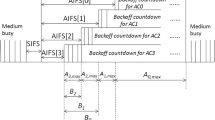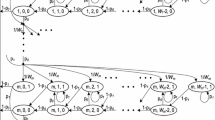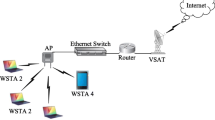Abstract
IEEE 802.11 Wireless LAN (WLAN) has become a prevailing solution for broadband wireless Internet access while the Transport Control Protocol (TCP) is the dominant transport-layer protocol in the Internet. Therefore, it is critical to have a good understanding of the TCP dynamics over WLANs. In this paper, we conduct rigorous and comprehensive modeling and analysis of the TCP performance over the emerging 802.11e WLANs, or more specifically, the 802.11e Enhanced Distributed Channel Access (EDCA) WLANs. We investigate the effects of minimum contention window sizes and transmission opportunity (TXOP) limits (of both the AP and stations) on the aggregate TCP throughput via analytical and simulation studies. We show that the best aggregate TCP throughput performance can be achieved via AP’s contention-free access for downlink packet transmissions and the TXOP mechanism. We also study the effects of some simplifying assumptions used in our analytical model, and simulation results show that our model is reasonably accurate, particularly, when the wireline delay is small and/or the packet loss rate is low.












Similar content being viewed by others
Notes
The TCP window sizes are actually maintained in bytes. In our model, for simplicity, we assume that the TCP Data packets have a fixed size and are transmitted at a fixed rate. Hence, the TCP window sizes can be measured in packets. Similar analysis could be done for variable packet sizes and multi-rate WLANs, which is omitted due to space limitation.
Actually, typical TCP configurations of commercial operating systems use a larger receive window size, e.g., the 12-packet (or 17520-byte) window used in MS Windows XP. We basically consider the 4-packet receive window size in order to reduce the calculation overhead; similar trends can be observed for other receive window sizes.
In this paper, TCP Ack processing delay is defined as time duration between a TCP Data reception and the corresponding TCP Ack arrival at the MAC Service Access Point (SAP).
References
The Network Simulator — ns-2. http://www.isi.edu/nsnam/ns/
Bianchi G (2000) Performance analysis of the IEEE 802.11 distributed coordination function. IEEE J Select Areas Commun 18(3):535–547
Bruno R, Conti M, Gregori E (2004) Analytical modeling of TCP clients in Wi-Fi hot spot networks. In: Proc. IFIP/TC6 networking. Athens, 9–14 May 2004
Burmeister C, Killat U (2006) TCP over rate-adaptive WLAN-An analytical model and its simulative verification. In: Proc. IEEE WoWMoM. Niagara-Falls, Buffalo, 26–29 June 2006
Cali F, Conti M, Gregori E (2000) Dynamic tuning of the IEEE 802.11 protocol. IEEE/ACM Trans Netw 8(6):785–799
Choi S, Park K, Kim C (2006) Performance impact of interlayer dependence in infrastructure WLANs. IEEE Trans Mobile Comput 5(7):829–845
Fall K, Floyd S (1996) Simulation-based comparisons of Tahoe, Reno, and SACK TCP. ACM SIGCOMM Comput Commun Rev (CCR) 26(3):5–21
IEEE std (1999) IEEE 802.11-1999, Part 11: wireless LAN Medium Access Control (MAC) and Physical Layer (PHY) specifications
IEEE std (2005) IEEE 802.11e, Part 11: wireless LAN Medium Access Control (MAC) and Physical Layer (PHY) specifications: medium access control quality of service enhancements
Jiang H, Dovrolis C (2005) Why is the internet traffic bursty in short time scales? In: Proc. ACM SIGMETRICS. Banff, 6–10 June 2005
Kherani AA, Shorey R (2006) Modelling TCP performance in Multihop 802.11 networks with randomly varying channel. In: Proc. WILLOPAN. New Delhi, January 2006
Stevens WR TCP/IP illustrated, vol 1, the protocols, 2nd edn. Addison-Wesley Reading
Tinnirello I, Choi S (2005) Temporal fairness provisioning in multi-rate contention-based 802.11e WLANs. In: Proc. IEEE WoWMoM. Taormina, 13–16 June 2005
Yamasaki Y, Shimonishi H, Murase T (2005) Statistical estimation of TCP packet loss rate from sampled ACK packets. In: Proc. IEEE GLOBECOM. St. Louis, 28 November– 2 December 2005
Yu J, Choi S (2006) Comparison of modified dual queue and EDCA for VoIP over IEEE 802.11 WLAN. European Trans Telecomms 17(3):371–382
Yu J, Choi S (2007) Modeling and analysis of TCP dynamics over IEEE 802.11 WLAN. In: Proc. IEEE/IFIP WONS. Obergurgl, 24–26 January 2007
Yu J, Choi S, Lee J (2004) Enhancement of VoIP over IEEE 802.11 WLAN via dual queue strategy. In: Proc. IEEE ICC. Paris, 20–24 June 2004
Zhai H, Chen X, Fang Y (2005) How well can the IEEE 802.11 wireless LAN support quality of service? IEEE Trans Wireless Commun 4(6):3084–3094
Acknowledgements
This work was in part supported by the ITRC support program of MKE/IITA (IITA-2008-C1090-0801-0013 and IITA-2008-C1090-0803-0004).
Author information
Authors and Affiliations
Corresponding author
Rights and permissions
About this article
Cite this article
Yu, J., Choi, S. & Qiao, D. Analytical Study of TCP Performance over IEEE 802.11e WLANs. Mobile Netw Appl 14, 470–485 (2009). https://doi.org/10.1007/s11036-008-0111-z
Published:
Issue Date:
DOI: https://doi.org/10.1007/s11036-008-0111-z




